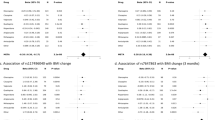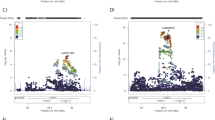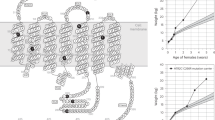Abstract
Background/objectives:
Melanocortins have a crucial role in appetite and weight regulation. Although the melanocortin 4 receptor (MC4R) gene has been repeatedly linked to obesity and antipsychotic-induced weight gain, the mechanism behind how it leads to this effect in still undetermined. The goal of this study was to conduct an in-depth and sophisticated analysis of MC4R polymorphisms, body mass index (BMI), eating behavior and depressed mood.
Subjects/methods:
We genotyped 328 individuals of European ancestry on the following MC4R markers based on the relevant literature on obesity and antipsychotic-induced weight gain: rs571312, rs17782313, rs489693, rs11872992, and rs8087522. Height and weight were measured, and information on depressed mood and overeating behaviors was obtained during the in-person assessment.
Results:
BMI was associated with rs17782313 C allele; however, this finding did not survive correction for multiple testing (P=0.018). Although rs17782313 was significantly associated with depressed mood and overeating behaviors, tests of indirect effects indicated that emotional eating and food cravings, rather than depressed mood, uniquely accounted for the effect of this marker and BMI (n=152).
Conclusions:
To our knowledge, this is the first study to investigate the link between MC4R rs17782313, mood and overeating behavior, as well as to demonstrate possible mechanisms behind MC4R’s influence on body weight. If replicated in a larger sample, these results may have important clinical implications, including potential for the use of MC4R agonists in the treatment of obesity and disordered eating.
This is a preview of subscription content, access via your institution
Access options
Subscribe to this journal
Receive 12 print issues and online access
$259.00 per year
only $21.58 per issue
Buy this article
- Purchase on Springer Link
- Instant access to full article PDF
Prices may be subject to local taxes which are calculated during checkout


Similar content being viewed by others
References
WHO Global Infobase. BMI/overweight/obesity Prevalence. World Health Organization: United States of America, 2006. Available from http://infobase.who.int.
Fuemmeler BF, Agurs-Collins TD, McClernon FJ, Kollins SH, Kail ME, Bergen AW et al. Genes implicated in serotonergic and dopaminergic functioning predict BMI categories. Obesity (Silver Spring) 2008; 16: 348–355.
Need AC, Ahmadi KR, Spector TD, Goldstein DB . Obesity is associated with genetic variants that alter dopamine availability. Ann Hum Genet 2006; 70 (Pt 3): 293–303.
Grayson BE, Seeley RJ . Deconstructing obesity: the face of fatness before and after the discovery of leptin. Diabetologia 2012; 55: 3–6.
Huszar D, Lynch CA, Fairchild-Huntress V, Dunmore JH, Fang Q, Berkemeier LR et al. Targeted disruption of the melanocortin-4 receptor results in obesity in mice. Cell 1997; 88: 131–141.
Santini F, Maffei M, Pelosini C, Salvetti G, Scartabelli G, Pinchera A . Melanocortin-4 receptor mutations in obesity. Adv Clin Chem 2009; 48: 95–109.
Srisai D, Gillum MP, Panaro BL, Zhang XM, Kotchabhakdi N, Shulman GI et al. Characterization of the hyperphagic response to dietary fat in the MC4R knockout mouse. Endocrinology 2011; 152: 890–902.
Loos RJ, Lindgren CM, Li S, Wheeler E, Zhao JH, Prokopenko I et al. Common variants near MC4R are associated with fat mass, weight and risk of obesity. Nat Genet 2008; 40: 768–775.
Willer CJ, Speliotes EK, Loos RJ, Li S, Lindgren CM, Heid IM et al. Six new loci associated with body mass index highlight a neuronal influence on body weight regulation. Nat Genet 2009; 41: 25–34.
Speliotes EK, Willer CJ, Berndt SI, Monda KL, Thorleifsson G, Jackson AU et al. Association analyses of 249,796 individuals reveal 18 new loci associated with body mass index. Nat Genet 2010; 42: 937–948.
Scherag A, Dina C, Hinney A, Vatin V, Scherag S, Vogel CI et al. Two new Loci for body-weight regulation identified in a joint analysis of genome-wide association studies for early-onset extreme obesity in French and german study groups. PLoS Genet 2010; 6: e1000916.
Wang K, Li WD, Zhang CK, Wang Z, Glessner JT, Grant SF et al. A genome-wide association study on obesity and obesity-related traits. PLoS One 2011; 6: e18939.
Paternoster L, Evans DM, Nohr EA, Holst C, Gaborieau V, Brennan P et al. Genome-wide population-based association study of extremely overweight young adults—the GOYA study. PLoS One 2011; 6: e24303.
Beckers S, Zegers D, de Freitas F, Mertens IL, Van Gaal LF, Van Hul W . Association study of MC4R with complex obesity and replication of the rs17782313 association signal. Mol Genet Metab 2011; 103: 71–75.
Kilpelainen TO, den Hoed M, Ong KK, Grontved A, Brage SEarly Growth Genetics Consortium et al. Obesity-susceptibility loci have a limited influence on birth weight: a meta-analysis of up to 28,219 individuals. Am J Clin Nutr 2011; 93: 851–860.
Zhao J, Bradfield JP, Zhang H, Sleiman PM, Kim CE, Glessner JT et al. Role of BMI-associated loci identified in GWAS meta-analyses in the context of common childhood obesity in European Americans. Obesity (Silver Spring) 2011; 19: 2436–2439.
Malhotra AK, Correll CU, Chowdhury NI, Muller DJ, Gregersen PK, Lee AT et al. Association between common variants near the melanocortin 4 receptor gene and severe antipsychotic drug-induced weight gain. Arch Gen Psychiatry 2012; 69: 904–912.
Chowdhury NI, Tiwari AK, Souza RP, Zai CC, Shaikh SA, Chen S et al. Genetic association study between antipsychotic-induced weight gain and the melanocortin-4 receptor gene. Pharmacogenomics J 2012; 13: 272–279.
Atalayer D, Robertson KL, Haskell-Luevano C, Andreasen A, Rowland NE . Food demand and meal size in mice with single or combined disruption of melanocortin type 3 and 4 receptors. Am J Physiol Regul Integr Comp Physiol 2010; 298: R1667–R1674.
Hasselbalch AL, Angquist L, Christiansen L, Heitmann BL, Kyvik KO, Sorensen TI . A variant in the fat mass and obesity-associated gene (FTO) and variants near the melanocortin-4 receptor gene (MC4R) do not influence dietary intake. J Nutr 2010; 140: 831–834.
Bauer F, Elbers CC, Adan RA, Loos RJ, Onland-Moret NC, Grobbee DE et al. Obesity genes identified in genome-wide association studies are associated with adiposity measures and potentially with nutrient-specific food preference. Am J Clin Nutr 2009; 90: 951–959.
Valladares M, Dominguez-Vasquez P, Obregon AM, Weisstaub G, Burrows R, Maiz A et al. Melanocortin-4 receptor gene variants in Chilean families: association with childhood obesity and eating behavior. Nutr Neurosci 2010; 13: 71–78.
Ho-Urriola J, Guzman-Guzman IP, Smalley SV, Gonzalez A, Weisstaub G, Dominguez-Vasquez P et al. Melanocortin-4 receptor polymorphism rs17782313: Association with obesity and eating in the absence of hunger in Chilean children. Nutrition 2014; 30: 145–149.
Zhou L, Williams T, Lachey JL, Kishi T, Cowley MA, Heisler LK . Serotonergic pathways converge upon central melanocortin systems to regulate energy balance. Peptides 2005; 26: 1728–1732.
Xu Y, Jones JE, Lauzon DA, Anderson JG, Balthasar N, Heisler LK et al. A serotonin and melanocortin circuit mediates D-fenfluramine anorexia. J Neurosci 2010; 30: 14630–14634.
Lim BK, Huang KW, Grueter BA, Rothwell PE, Malenka RC . Anhedonia requires MC4R-mediated synaptic adaptations in nucleus accumbens. Nature 2012; 487: 183–189.
Beck AT, Ward CH, Mendelson M, Mock J, Erbaugh J . An inventory for measuring depression. Arch Gen Psychiatry 1961; 4: 561–571.
Halmi KA, Falk JR, Schwartz E . Binge-eating and vomiting: a survey of a college population. Psychol Med 1981; 11: 697–706.
Lowe MR, Butryn ML, Didie ER, Annunziato RA, Thomas JG, Crerand CE et al. The Power of Food Scale. A new measure of the psychological influence of the food environment. Appetite 2009; 53: 114–118.
van Strien T, Frijters JER, Bergers GPA, Defares PB . The Dutch Eating Behavior Questionnaire (DEBQ) for assessment of restrained, emotional, and external eating behavior. Int J Eat Disorder 1986; 5: 295–315.
Schlundt DG, Hargreaves MK, Buchowski MS . The Eating Behavior Patterns Questionnaire predicts dietary fat intake in African American women. J Am Diet Assoc 2003; 103: 338–345.
Cepeda-Benito A, Gleaves DH, Williams TL, Erath SA . The development and validation of the state and trait food-cravings questionnaires. Behav Ther 2000; 31: 151–173.
Lahiri DK, Nurnberger JI Jr . A rapid non-enzymatic method for the preparation of HMW DNA from blood for RFLP studies. Nucleic Acids Res 1991; 19: 5444.
Nyholt DR . A simple correction for multiple testing for single-nucleotide polymorphisms in linkage disequilibrium with each other. Am J Hum Genet 2004; 74: 765–769.
Baron RM, Kenny DA . The moderator–mediator variable distinction in social psychological research: conceptual, strategic, and statistical considerations. J Pers Soc Psychol 1986; 51: 1173–1182.
Preacher KJ, Hayes AF . Asymptotic and resampling strategies for assessing and comparing indirect effects in multiple mediator models. Behav Res Methods 2008; 40: 879–891.
Hair JF, Black B, Babin B, Anderson RE . Multivariate Data Analysis, 7th edn. Pearson Education Inc: New Jersey, 2009.
American Psychiatric Association. Diagnostic and Statistical Manual of Mental Disorders, 5th edn. American Psychiatric Association: Washington DC, USA, 2013.
Levitan RD, Davis C, Kaplan AS, Arenovich T, Phillips DI, Ravindran AV . Obesity comorbidity in unipolar major depressive disorder: refining the core phenotype. J Clin Psychiatry 2012; 73: 1119–1124.
Cizza G, Ronsaville DS, Kleitz H, Eskandari F, Mistry S, Torvik S et al. Clinical subtypes of depression are associated with specific metabolic parameters and circadian endocrine profiles in women: the power study. PLoS One 2012; 7: e28912.
Ganley RM . Emotional eating and how it relates to dietary restraint, disinhibition, and perceived hunger. Int J Eat Disorder 1988; 7: 635–647.
Kaplan AS, Howlett AL, Yilmaz Z, Levitan RD . Attention deficit hyperactivity disorder and binge eating: shared phenomenology, genetics and response to treatment. Int J Child Health Adolesc Health 2009; 2: 165.
Davis C . Attention-deficit/hyperactivity disorder: associations with overeating and obesity. Curr Psychiatry Rep 2010; 12: 389–395.
Vannucci A, Tanofsky-Kraff M, Crosby RD, Ranzenhofer LM, Shomaker LB, Field SE et al. Latent profile analysis to determine the typology of disinhibited eating behaviors in children and adolescents. J Consult Clin Psychol 2013; 81: 494–507.
Mailloux G, Bergeron S, Meilleur D, D'Antono B, Dube I . Examining the associations between overeating, disinhibition, and hunger in a nonclinical sample of college women. Int J Behav Med 2013; 21: 375–384.
Horstmann A, Kovacs P, Kabisch S, Boettcher Y, Schloegl H, Tonjes A et al. Common genetic variation near MC4R has a sex-specific impact on human brain structure and eating behavior. PLoS One 2013; 8: e74362.
Panaro BL, Cone RD . Melanocortin-4 receptor mutations paradoxically reduce preference for palatable foods. Proc Natl Acad Sci USA 2013; 110: 7050–7055.
Stutzmann F, Cauchi S, Durand E, Calvacanti-Proenca C, Pigeyre M, Hartikainen AL et al. Common genetic variation near MC4R is associated with eating behaviour patterns in European populations. Int J Obes (Lond) 2009; 33: 373–378.
Levitan RD, Masellis M, Basile VS, Lam RW, Kaplan AS, Davis C et al. The dopamine-4 receptor gene associated with binge eating and weight gain in women with seasonal affective disorder: an evolutionary perspective. Biol Psychiatry 2004; 56: 665–669.
Avena NM, Bocarsly ME, Rada P, Kim A, Hoebel BG . After daily bingeing on a sucrose solution, food deprivation induces anxiety and accumbens dopamine/acetylcholine imbalance. Physiol Behav 2008; 94: 309–315.
Davis C, Levitan RD, Kaplan AS, Carter J, Reid C, Curtis C et al. Reward sensitivity and the D2 dopamine receptor gene: a case-control study of binge eating disorder. Prog Neuropsychopharmacol Biol Psychiatry 2008; 32: 620–628.
Hersrud SL, Stoltenberg SF . Epistatic interaction between COMT and DAT1 genes on eating behavior: a pilot study. Eat Behav 2009; 10: 131–133.
Davis C, Levitan RD, Yilmaz Z, Kaplan AS, Carter JC, Kennedy JL . Binge eating disorder and the dopamine D2 receptor: genotypes and sub-phenotypes. Prog Neuropsychopharmacol Biol Psychiatry. 2012; 38: 328–335.
Davis JF, Choi DL, Shurdak JD, Krause EG, Fitzgerald MF, Lipton JW et al. Central melanocortins modulate mesocorticolimbic activity and food seeking behavior in the rat. Physiol Behav 2011; 102: 491–495.
Cui H, Mason BL, Lee C, Nishi A, Elmquist JK, Lutter M . Melanocortin 4 receptor signaling in dopamine 1 receptor neurons is required for procedural memory learning. Physiol Behav 2012; 106: 201–210.
Rowland NE, Fakhar KJ, Robertson KL, Haskell-Luevano C . Effect of serotonergic anorectics on food intake and induction of Fos in brain of mice with disruption of melanocortin 3 and/or 4 receptors. Pharmacol Biochem Behav 2010; 97: 107–111.
Marston OJ, Garfield AS, Heisler LK . Role of central serotonin and melanocortin systems in the control of energy balance. Eur J Pharmacol 2011; 660: 70–79.
Kumar KG, Sutton GM, Dong JZ, Roubert P, Plas P, Halem HA et al. Analysis of the therapeutic functions of novel melanocortin receptor agonists in MC3R- and MC4R-deficient C57BL/6J mice. Peptides 2009; 30: 1892–1900.
Acknowledgements
This study was funded by a Canadian Institutes of Health Research (CIHR) operating grant awarded to CD (PI), JCC, ASK, JLK and RDL. ZY was funded by a CIHR Doctoral Research Award when the study was performed and is currently supported by the National Institutes of Health (NIH) Grant T32MH076694 (PI: Cynthia M Bulik). We thank Dr Jo Knight for statistical support and Ms Natalie Freeman for laboratory support.
Author information
Authors and Affiliations
Corresponding author
Ethics declarations
Competing interests
JLK has received honoraria from Eli Lilly and Roche, whereas RDL has received honorarium from Astra-Zeneca. The remaining authors declare no conflict of interest.
Rights and permissions
About this article
Cite this article
Yilmaz, Z., Davis, C., Loxton, N. et al. Association between MC4R rs17782313 polymorphism and overeating behaviors. Int J Obes 39, 114–120 (2015). https://doi.org/10.1038/ijo.2014.79
Received:
Revised:
Accepted:
Published:
Issue Date:
DOI: https://doi.org/10.1038/ijo.2014.79
This article is cited by
-
The interaction between MC4R gene variant (rs17782313) and dominant dietary patterns on depression in obese and overweight women: a cross sectional study
BMC Endocrine Disorders (2023)
-
Interaction of fatty acid quality indices and genes related to lipid homeostasis on mental health among overweight and obese women
Scientific Reports (2023)
-
Association and interaction of the MC4R rs17782313 polymorphism with plasma ghrelin, GLP-1, cortisol, food intake and eating behaviors in overweight/obese Iranian adults
BMC Endocrine Disorders (2022)
-
Relationship between a near Melanocortin-4 receptor gene variant and puberty timing in children is vague unlike obesity
Journal of Diabetes & Metabolic Disorders (2022)
-
Interaction between ultra-processed food intake and genetic risk score on mental health and sleep quality
Eating and Weight Disorders - Studies on Anorexia, Bulimia and Obesity (2022)



